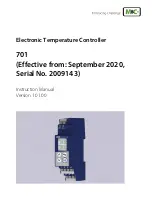
CHAPTER 20 SIP Definitions
Mediant 4000 SBC | User's Manual
■
Example 6: See
Configuring an HTTP GET Web Service
on page 259 for an example on HTTP
GET.
Configuring Dial Plans
Dial Plans let you categorize incoming calls (source and/or destination) according to source and/or
destination numbers . The device categorizes them by searching in the Dial Plan for rules that
match these numbers according to prefix, suffix, and/or whole number. The categorization result in
the Dial Plan is a
tag
corresponding to the matched rule. You can then use tags to represent these
calls (source and/or destination) as matching characteristics (source and/or destination tags) for
various configuration entities:
■
SBC application:
●
IP-to-IP Routing rules (see
Using Dial Plan Tags for IP-to-IP Routing
●
Outbound Manipulations rules (
Using Dial Plan Tags for Outbound Manipulation
)
●
Call Setup Rules (
Using Dial Plan Tags for Call Setup Rules
●
Message Manipulation (
Using Dial Plan Tags for Message Manipulation
You can assign a Dial Plan to an IP Group or SRD. After Classification and Inbound
Manipulation, the device checks if a Dial Plan is associated with the incoming call. It first
checks the source IP Group and if no Dial Plan is assigned, it checks the SRD. If a Dial Plan is
assigned to the IP Group or SRD, the device first searches the Dial Plan for a dial plan rule that
matches the source number and then it searches the Dial Plan for a rule that matches the
destination number. If matching dial plan rules are found, the tags configured for these rules are
used in the routing and/or manipulation processes as source and/or destination tags.
Notes for the SBC application:
●
User categorization by Dial Plan is done only after the device's Classification and
Inbound Manipulation processes, and before the routing process.
●
Once the device successfully categorizes an incoming call by Dial Plan, it not only
uses the resultant tag in the immediate routing or manipulation process, but also in
subsequent routing and manipulation processes that may occur, for example, due
to alternative routing or local handling of call transfer and call forwarding (SIP
3xx\REFER).
●
For manipulation, tags are applicable only to outbound manipulation.
●
When tags are used in the IP-to-IP Routing table to determine destination IP
Groups (i.e., 'Destination Type' parameter configured to
Destination Tag
), the
device searches the Dial Plan for a matching
destination
(called) prefix number
only.
The figure below shows a conceptual example of routing based on tags, where users categorized
as tag "A" are routed to SIP Trunk "X" and those categorized as tag "B" are routed to SIP Trunk "Y":
- 462 -
Содержание Mediant 4000 SBC
Страница 1: ...User s Manual AudioCodes Series of Session Border Controllers SBC Mediant 4000 SBC Version 7 2...
Страница 40: ...Part I Getting Started with Initial Connectivity...
Страница 48: ...Part II Management Tools...
Страница 113: ...Part III General System Settings...
Страница 118: ...Part IV General VoIP Configuration...
Страница 525: ...Part V Session Border Controller Application...
Страница 654: ...Part VI Cloud Resilience Package...
Страница 663: ...Part VII High Availability System...
Страница 685: ...Part VIII Maintenance...
Страница 759: ...Part IX Status Performance Monitoring and Reporting...
Страница 844: ...Part X Diagnostics...
Страница 888: ...Part XI Appendix...
Страница 1036: ...This page is intentionally left blank CHAPTER 62 Technical Specifications Mediant 4000 SBC User s Manual 1003...
















































